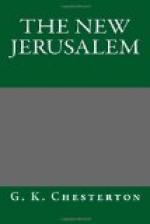As soon as the men of science began to doubt the rules of the game, the game was up. They could no longer rule out all the old marvels as impossible, in face of the new marvels which they had to admit as possible. They were themselves dealing now with a number of unknown quantities; what is the power of mind over matter; when is matter an illusion of mind; what is identity, what is individuality, is there a limit to logic in the last extremes of mathematics? They knew by a hundred hints that their non-miraculous world was no longer watertight; that floods were coming in from somewhere in which they were already out of their depth, and down among very fantastical deep-sea fishes. They could hardly feel certain even about the fish that swallowed Jonah, when they had no test except the very true one that there are more fish in the sea than ever came out of it. Logically they would find it quite as hard to draw the line at the miraculous draught of fishes. I do not mean that they, or even I, need here depend on those particular stories; I mean that the difficulty now is to draw a line, and a new line, after the obliteration of an old and much more obvious line. Any one can draw it for himself, as a matter of mere taste in probability; but we have not made a philosophy until we can draw it for others. And the modern men of science cannot draw it for others. Men could easily mark the contrast between the force of gravity and the fable of the Ascension. They cannot all be made to see any such contrast between the levitation that is now discussed as a possibility and the ascension which is still derided as a miracle. I do not even say that there is not a great difference between them; I say that science is now plunged too deep in new doubts and possibilities to have authority to define the difference. I say the more it knows of what seems to have happened, or what is said to have happened, in many modern drawing-rooms, the less it knows what did or did not happen on that lofty and legendary hill, where a spire rises over Jerusalem and can be seen beyond Jordan.




